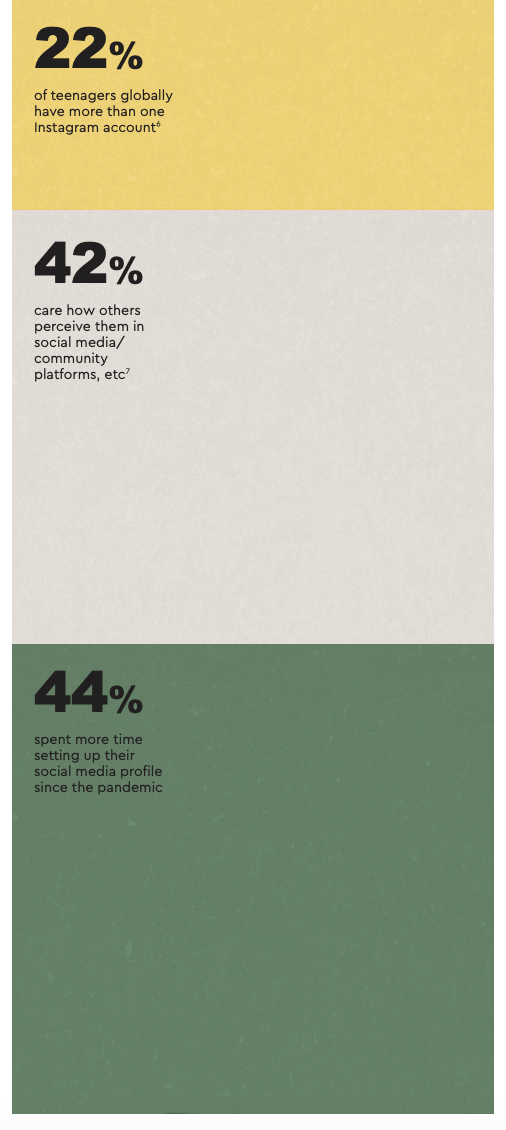
Elastic identities
Explore how brands can engage with the wave of #ID culture and what might come next
As digital acceleration is pushing boundaries, cultural identities are in flux. People are defining themselves in richer, ever complex and more fluid ways. Examples include movements such as Black Lives Matter and Extinction Rebellion; gender identities; and other forms of ID, such as being ‘self-partnered’. Values related to cultural identity are evolving and adapting, in physical and digital environments. As identities become more elastic and flexible, brands can grow by communicating and interacting effectively with people and communities.
Sense of identity
Self-identity: At one level, our ‘identity’ is who we are as individuals. Indeed, 70% of people worldwide say their self-knowledge is important to their perception of who they are. 1
Individuality is also a key trend: in recent years we have seen a growing tendency towards the personalisation of experiences and products. Younger generations are challenging gender stereotypes. Facebook users, for example, can choose from more than 70 custom gender options. The spectrum ranges from non-binary (people who consider themselves of a neutral gender) to neutrois (having no gender at all).
Meanwhile, the popularity of DNA testing shows people are on a journey of self-discovery even at a genetic level. The MIT Technology Review estimates that by the start of 2019, more than 26 million people had bought testing kits, a figure projected to rise to 100 million in 2021.
Identities are intertwined and contextual, and this drives behaviour. Globalisation has caused nationalities, ethnicities, interests, cultures and beliefs to mix more than ever. We may have a sense of belonging to one nation or more than one. We identify with a county or a city. People in England, for example, may feel English, British, something else, or a mixture.
Collective identity: Identity is also how we identify with others. The ‘social self’ has grown as an important factor for consumers’ identity – from 20% in 2017 to 62% in 2020. 2
Identity is crucial to people’s wellbeing and aspirations. It influences what individuals do and how they make sense of the world. It shapes their habits, attitudes, what they take for granted, and how they relate to others – which are all central to community life. In this context, for example, sociologists and psychologists refer to the ‘in-group’, as a social group, of which a person psychologically identifies as being a member. People may, for example, identify with their peer group, sporting team or political party. Examples also include United States-style motorcycle clubs in Kuwait; or radical feminists using colour-coded scarfs in different countries in Latin America.
Identity is a link: It connects individuals to their communities and in-groups. Yet identities are also flexible: people have diverse lives that aren’t contained within a single idea of one identity. Instead, identities evolve. Life in front of family members is not the same life when meeting with friends and engaging online.
Football fans’ shifting bonds
Group membership drives action but is not fixed. Researchers from the University of Lancaster conducted a famous study to test this relationship. This showed that when a football team’s supporters engage with other fans, they will align with, and create in-group communities with, their team’s fellow supporters. But when the context is football as a sport, supporters will engage with other fans regardless of their team allegiance. This shows how identities can be multidimensional and contextual.
Individuals are multifaceted, actually more like diamonds. Look from a different angle, and you see something completely different - Chris Poole, 4chan Founder
Identity in digital spaces
Thriving communities
Digital platforms have expanded the idea of collaboration and co-operation – developing a shared sense of identity across time zones and continents. Social sharing is changing the landscape of people’s identities globally – from sharing as a method of broadcasting themselves, to an action that has the community at its heart.
Communities operate in different spaces of society. These might be related to climate change or diversity and inclusion activism, and movements such as #MeToo or Extinction Rebellion. More broadly, every significant youth cultural movement since the mid-20th Century has had its own special space, where members could go and be themselves.
Limitless experiences
In a digital world, there’s no limit to how many spaces our virtual selves can live in. Like personal identities, communities are complex and fluid, and emphasise belonging and common purpose. People fulfil a need to socialise and to express themselves by belonging to certain communities in different platforms – and also when they perform actions, such as confirming things they know, liking or disliking posts, and even making comments about themselves and reacting to other comments. The fragmented nature of digital platforms allows us to explore, shift or experiment with multiple identities – allowing aspects of our identities to intersect.
40% show a different side of themselves depending on the social media/ digital platform they are using. 3
Identity freedom
Digital platforms allow people freedom on how they construct their identity. Technology allows us to produce a narrative of our lives, to choose what to remember and what to contribute to our own multiple stories. People rely more and more on search results to help build a picture of themselves, and digital platforms are becoming a tool for personal branding and identity management.
Yet the proliferation of padlocked accounts is evidence of how many consumers are struggling with social media and in finding an outlet to be themselves. The digital space allows us different ways to express our identity. Facebook, for example, requires people to use their own names; Reddit allows multiple accounts; and 4chan offers total anonymity.
How brands can engage
Engaging with communities
The challenge for brands is to understand, entertain and engage different communities on specific media platforms. They can use features on these platforms, for example, to put a fresh spin on identity. Examples include a ‘mix and match’ Bitmoji (a type of personal emoji) feature on Snapchat, displaying looks from fashion brand Ralph Lauren. And when the relationship is nurtured, an online community becomes a brand’s strongest advocate and biggest asset – improving customer experience. For example, members of the Peloton community on Facebook share personal weight loss journeys and offer each other advice.
Branded communities
Brands are also building new platforms to bring communities together, launching products that fulfil people’s sense of identity. For example, Nike’s Snkrs app allows fans of the brand to stay up to date with its latest trainers.
The Finstagram phenomenon
In an official Instagram account, users can tailor and filter their own images. But people may also create ‘Finstagram’ (fake Instagram) profiles which are more unfiltered and uncensored. These are usually more authentic, off-the-cuff and for close friends. Finstagram is on the rise among Generation Z Instagram users – and is also starting to filter to Millennials.
62% agree that their country will not make it through COVID-19 without brands playing a critical role in addressing the challenges ahead. 4
A branded community is a place where meaningful feedback can be collected by members to help improve products and services, shape future developments, and increase customer retention and loyalty.
During the pandemic, brands played a proactive role in supporting and engaging different communities. For example, the Early Days Club from Waterwipes, a brand of baby wipes, connects new and expectant parents. And as part of Oreo’s #cookiewithacause challenge, the brand donated to Save the Children.
Communities benefit from brands getting involved in their physical environment, too. Brands can strengthen communities with social initiatives to boost member interaction and engagement. For example, Pantene salons offer a safe space for the trans community, while a Starbucks volunteer-matching service helps community members engage with each other. 50% need to be involved in the life of their communities. 5
What’s next for #ID culture?
A generic view of an audience is not enough. We need to provide a more contemporary understanding of audience identity and behaviour.
Customised identity: We are starting to understand consumers’ identities across media platforms and devices which store cultural signals and identifiers that correlate with an individual consumer.
Effective engagement: In the omnichannel and fragmented media world, consumers are using multiple channels, platforms and digital devices to connect to the internet, offering more paths to engage with their identities.
Different identities: Brands can take advantage of multiple identities through digital platforms. These can be used as a way to communicate with consumers in varied ways, fragmenting marketing objectives into different audience identities.
Different purposes: Brands need to find the right cultural moment, purpose or initiative to engage with identities and their communities. They also need to strike a balance as to when and how to engage with different identities, especially if their communities want a more exclusive space.
Different sites: When engaging in different digital spaces, brands should understand their ethos and culture, and authentically align their values. Brands can also create their own spaces – and bring communities together for a specific purpose.

|
published on
15 December 2021
Category
More in The Atticus Journal

Generative AI: mitigating risk to unlock opportunity
H+K’s Allison Spray on managing the commercial and reputational risks that the proliferation of generative AI will present

Making sustainability profitable
Sustainability investments must deliver returns – both financial and reputational – to be ‘sustainable’ for business. Something needs to change, says Luc Speisser

Sustainability comms must get real
There’s a disconnect between the way corporations talk about climate change and how the public discusses the same issue. That’s the conclusion of research by Jamie Hamill, Alessia Calcabrini and Alex Kibblewhite.

